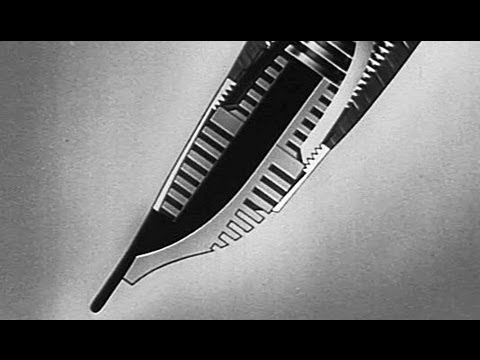more at
“Development of writing and writing tools throughout history.”
NEW VERSION with improved video & sound:
Public domain film from the Library of Congress Prelinger Archive, slightly cropped to remove uneven edges, with the aspect ratio corrected, and mild video noise reduction applied.
The soundtrack was also processed with volume normalization, noise reduction, clipping reduction, and/or equalization (the resulting sound, though not perfect, is far less noisy than the original).
A fountain pen is a nib pen that, unlike its predecessor the dip pen, contains an internal reservoir of water-based liquid ink. The pen draws ink from the reservoir through a feed to the nib and deposits it on paper via a combination of gravity and capillary action.
Filling the reservoir with ink may be achieved manually (via the use of a Pasteur pipette or syringe), or via an internal filling mechanism which creates suction (for example, through a piston mechanism) to transfer ink directly through the nib into the reservoir. Some pens employ removable reservoirs in the form of pre-filled ink cartridges. A fountain pen needs little or no pressure to write…
History
The earliest historical record of a reservoir pen dates to the 10th century. In 953, Ma’ād al-Mu’izz, the caliph of the Maghreb, demanded a pen that would not stain his hands or clothes, and was provided with a pen that held ink in a reservoir and delivered it to the nib, which could be held upside-down without leaking, as recorded in Kitab al-Majalis wa ‘l-musayardt, by Qadi al-Nu’man al-Tamimi (d. 974). No details of the construction or mechanism of operation of this pen are known, and no examples have survived…
In Deliciae Physico-Mathematicae (a 1636 magazine), German inventor Daniel Schwenter described a pen made from two quills. One quill served as a reservoir for ink inside the other quill. The ink was sealed inside the quill with cork. Ink was squeezed through a small hole to the writing point. Noted Maryland historian Hester Dorsey Richardson (1862–1933) documented a reference to “three silver fountain pens, worth 15 shillings” in England during the reign of Charles II, ca. 1649-1685. She also found a 1734 notation made by Robert Morris the elder in the ledger of the expenses of Robert Morris the younger, who was at the time in Philadelphia, for “one fountain pen”.
In 1828 Josiah Mason improved a cheap, efficient slip-in nib in Birmingham, England, which could be added to a fountain pen and in 1830, with the invention of a new machine, William Joseph Gillott, William Mitchell and James Stephen Perry devised a way to mass manufacture robust, cheap steel pen nibs. This boosted the Birmingham pen trade and by the 1850s, more than half the steel-nib pens manufactured in the world were made in Birmingham. Thousands of skilled craftsmen and -women were employed in the industry…
Progress in developing a reliable pen was slow until the mid-19th century, because of an imperfect understanding of the role that air pressure plays in the operation of pens and because most inks were highly corrosive and full of sedimentary inclusions. The Romanian inventor Petrache Poenaru received a French patent for the invention of the first fountain pen with a replaceable ink cartridge on May 25, 1827. Starting in the 1850s there was a steadily accelerating stream of fountain pen patents and pens in production. However, it was only after three key inventions were in place that the fountain pen became a widely popular writing instrument. Those were the iridium-tipped gold nib, hard rubber, and free-flowing ink.
The first fountain pens making use of all these key ingredients appeared in the 1850s…
The reservoirs of the earliest fountain pens were mostly filled by eyedropper…
The Conklin crescent filler, introduced c. 1901, was one of the first mass-produced self-filling pen designs…
In 1907 Walter A. Sheaffer patented the Lever filler, using a hinged lever set into the pen barrel which pressed down onto a bar which in turn compressed the rubber sac inside, creating a vacuum to force ink into the pen. Introduced in 1912, this innovation was rapidly imitated by the other major pen makers…
Sheaffer Pen Corporation is a manufacturer writing instruments, particularly luxury fountain pens. The company was founded by Walter A. Sheaffer in Fort Madison, Iowa, and incorporated in 1913 to exploit his invention of a lever-filling fountain pen. The brand is currently a subsidiary of French company Bic, with only a service facility remaining at Fort Madison. Sheaffer pens are still primarily developed in Italy…

